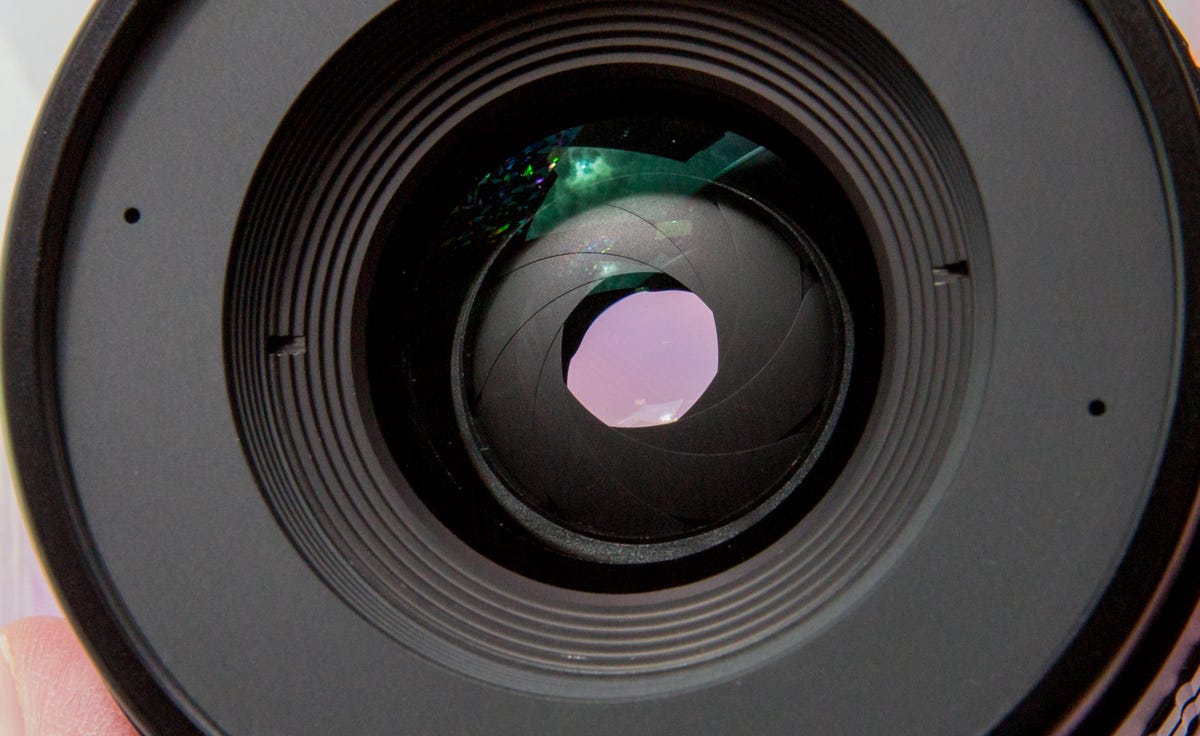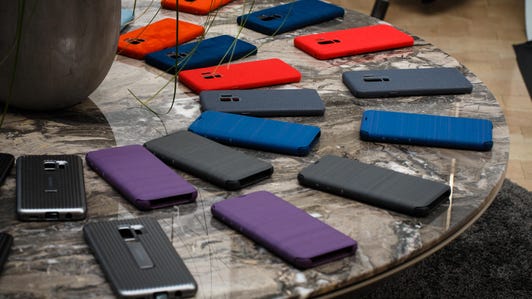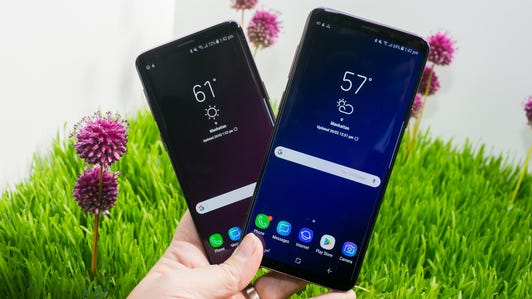For the Galaxy S9 ($198 at eBay) and Galaxy S9 Plus ($198 at eBay), Samsung added another tool to its photography arsenal: a variable aperture. This means pictures taken with both phones should look sharper, have less image noise and handle extreme lighting situations better.
The aperture of a lens determines the amount of light that a camera sensor receives. When my dad taught me how to take photos with a film camera, he told me to think of aperture like your eyes. When it’s bright, your eyes squint and when it’s dark your eyes open wide. The aperture inside a lens does the same thing for a camera.


If you look inside this lens, you can see 8 aperture blades that can widen and narrow to control exposure and depth of field.
Sarah Tew/CNET
If you look down the barrel of a DSLR lens you’ll see a series of aperture blades that form a circular opening. These blades can widen and narrow to different sizes. If it’s dark, the blades widen to let in more light. If it’s bright, they narrow to create a smaller opening that lets in less light. This technology is nothing new and has been around since the 1800s.
Most phones don’t use an aperture to control exposure because phone cameras have a fixed aperture. This means the aperture can’t be changed and remains at one setting no matter the situation. Phones compensate for this limitation by adjusting the light sensitivity (or ISO) and the shutter speed, which determines how long the sensor is exposed to light for a picture.
Take a look at the top camera on this Galaxy S9 Plus. You can see the aperture switching from wide to narrow.
Samsung
The Galaxy S9, on the other hand, has two aperture settings: One wide open and the other more narrow. To get to the best balance of exposure and sharpness for pictures, the S9 automatically switches between its two apertures.
More from Mobile World Congress
- Hands-on with the Galaxy S9 and S9 Plus
- MWC 2018: All the phones and gadgets announced so far
- Nokia 8 Sirocco is the swanky flagship we’ve been waiting for
- Everything Samsung just announced
So if you were taking a picture in a dark restaurant, the S9 might switch to its wide aperture to gather as much light as possible. This not only would help the picture look brighter but it might also reduce the noise — those blurry specs you get when a photo is too dark.
On a bright day, the S9 might use its narrow setting to prevent all that sunlight from overexposing a shot. This has an added benefit of improving a photo’s sharpness around the edges.
A lens’ sharpest spot is the middle, while the edges tend to be the softest. So when you use a narrow aperture, the blades form a ring blocking the outer edge of the lens. The result is a sharper photo with fewer distortions.


Now playing:
Watch this:
Samsung Galaxy S9’s new cameras have a bunch of new tricks
2:58
It should also be noted that with f/1.5, the Galaxy S9’s lens has the widest aperture ever seen on a phone. In recent years, phone makers have been topping one another by making the apertures of their lenses wider. A wider aperture corresponds to a lower f-stop number. The last two generations of iPhones ($285 at Amazon), including the iPhone X, have an aperture of f/1.8. Last year’s Galaxy S8 ($180 at eBay) had an aperture of f/1.7. And until the launch of the S9, the phone with the fastest lens was the LG V30 ($229 at Amazon) which had a crazy wide aperture of f/1.6.
The advantage of these insanely wide apertures is that they improve a camera’s performance in low-light situations. But the disadvantage is they can result in softer images. To compensate for this on a DSLR, a photographer will “stop their lens down” and shoot at a less wide aperture such as f/2.4 or f/2.8.
And that’s the genius of the S9’s dual-aperture system. It can use f/2.4 to capture sharp images in good light, and switch to a wider f/1.5 aperture to gather more light in a dark environment. It’s kind of like having your cake and eating it too.
A variable aperture on a phone might seem new, but Samsung wasn’t the first to implement it. That would be the Nokia N86 from 2009 which had three aperture settings. But the Galaxy S9 and S9 Plus are the first phones to have both a variable aperture and optical image stabilization (OIS). These features, combined with more powerful image processing, could put the S9 and S9 Plus at the forefront of phone photography.
I look forward to testing the cameras on both phones to see just how well they do. I’m also curious if the camera uses its dual-aperture when recording video. I guess we’ll find out in a few weeks!
MWC 2018: All the phones and gadgets announced so far






Galaxy S9 and S9 Plus: Hands-on with Samsung’s iPhone X fighters.
MWC 2018: All of CNET’s coverage from the biggest phone show of the year.



